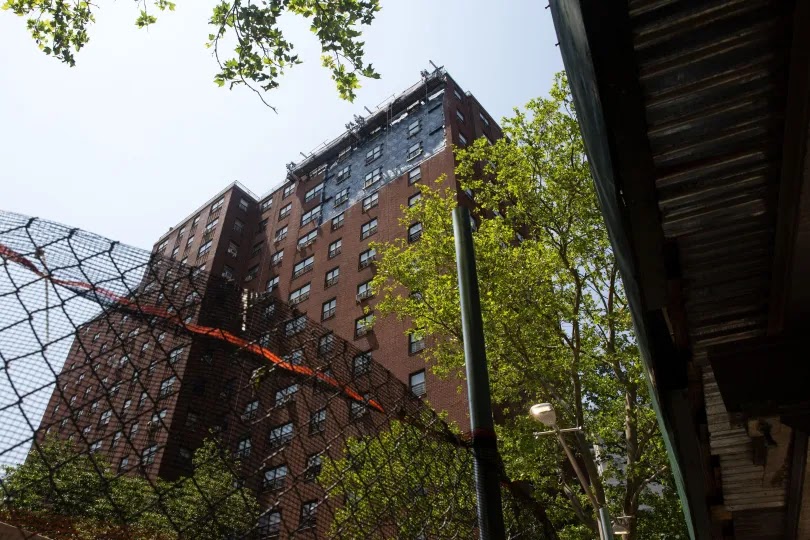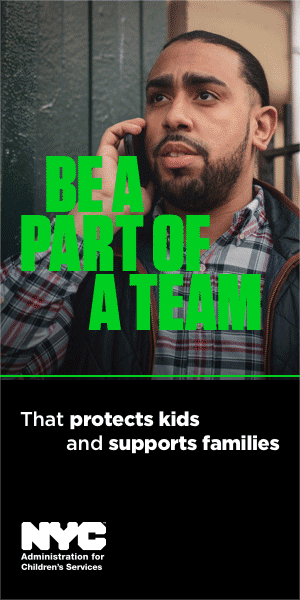Featured
- Get link
- X
- Other Apps
With Bricks Tumbling, NYCHA Needs $3 Billion to Fix Its Facades
Scaffolding surrounded around a Jackson Houses building where a large section of facade crashed to the ground last month. | Ben Fractenberg/THE CITY
This article was originally published on by THE CITY
NEW YORK - When hundreds of bricks fell last month from the 15th floor of a Bronx development and crushed a sidewalk shed set up to protect passersby, city Housing Authority staff discovered that some of the metal hooks that were supposed to have held the masonry in place were missing in action.
The Jackson Houses development, just a few blocks from Yankee Stadium, was cited by the city buildings department for facade safety violations in 2016, but the problems remained unresolved for years. Some of the bricks were essentially unattached to the wall and had simply stayed in place by pure luck for an unknown period of time.
The decrepit condition of these bricks highlights one of the most daunting and expensive tasks faced by NYCHA: resolving hundreds of open code violations for brickwork that pose potential danger across the city.
According to an internal analysis NYCHA compiled in an effort to confront this issue, the Housing Authority estimates it would need $3 billion to perform the necessary facade work on every building that requires it.
Even simply resolving every existing facade safety citation — there were more than 500 in Department of Buildings files as of this month — would cost between $750 million and $1 billion, according to a source familiar with NYCHA’s internal discussions about this issue.
That Jackson Houses building where the bricks fell off the wall would cost $10 million all by itself.
Given that the bricks on more than half of NYCHA’s apartment buildings were installed more than 50 years ago, the price of addressing this high-maintenance problem is enormous at a time when the Housing Authority is facing a fiscal calamity that’s even worse than prior crises.
Cold, Hard Facts
On Friday, NYCHA management will plead their case at a City Council budget hearing, spelling out the cold, hard facts of the ongoing struggle to maintain safe and healthy living conditions in 162,000 public housing apartments.
As of March, the backlog of unresolved tenant-initiated requests for day-to-day repairs had grown to 684,000, up 10% in just one year. Management says it would take $40 billion to bring all of NYCHA’s 2,100 buildings up to snuff, and the authority predicts budget deficits for the next five years. The authority’s day-to-day operating budget will come up $35 million short this year, and the shortfall is expected to climb to $56 million by 2027.
In an analysis released this week, the nonpartisan Independent Budget Office (IBO) flagged NYCHA funding as a “risk factor” in the city’s proposed fiscal 2024 budget, citing the most recent disastrous turn of events: a pandemic-related dive in rent collection.
As the state issued a COVID-related eviction ban in 2020, NYCHA paused some 30,000 “non-payment actions.” The authority only recently began moving forward to terminate the leases of around 500 of its 400,000 tenants, and only against those whose rent arrears exceeded two years. Combined with a wave of tenants who simply stopped paying rent in early 2020, NYCHA now has amassed rent arrears topping $466 million. The recently passed state budget provides some state-funded emergency rental assistance to NYCHA, but will likely cover only a fraction of the gap.
Finding funds to fix facades is thus highly unlikely in the immediate term, leaving NYCHA in a familiar dilemma: The condition of the bricks will only worsen and, in the end, cost even more to repair.
/cdn.vox-cdn.com/uploads/chorus_asset/file/24666739/051823_jackson_houses_facade_2.jpg)
And fixing bricks is expensive. NYCHA says it spends $30 million each year — mostly from federal funds — addressing unsafe conditions on building facades. An analysis by THE CITY of contract records shows that, since 2011, NYCHA has coughed up three-quarters of a billion dollars, or $726 million, to fix facades. That includes $292 million just to remedy what are known as Local Law 11 violations for failing brickwork.
Much of that money pays for the sidewalk sheds that clutter up developments, year after year, all over the city, while repairs are on hold. The sheds are reviled by tenants for creating dangerous hiding spots for criminal activity, and some of these sheds have been in place for as much as a decade. In just the last five years alone, NYCHA spent $80 million to install and maintain sidewalk sheds and temporary fencing for public protection due to facade safety risks.
Records show these sheds are everywhere. According to internal NYCHA data obtained by THE CITY, sheds or fences are in place at about 500 locations in public housing developments in all five boroughs to protect passersby from potentially falling bricks.
Finding Funds
There is one source of money already set aside for NYCHA that the authority would like to use to address its facade failures, but for the moment it remains off-limits.
As part of a January 2019 agreement with the federal government that resulted in the appointment of the monitor who now oversees NYCHA’s promised reforms, then-Mayor Bill de Blasio committed to allocate millions of city dollars each year through fiscal 2027 for NYCHA capital projects.
That city allocation averaged about $136 million each year starting in fiscal 2020. Much of that has already been spent, but as of last week, the city was still committed to spending another $500 million for this purpose through fiscal 2027.
But NYCHA can’t touch a dime of it to fix bricks. The city’s Office of Management and Budget, citing a June 2019 protocol from the city comptroller known as Directive 10, says that the money like that set aside in the NYCHA agreement for capital spending can only be used for comprehensive projects. OMB has to date taken the position that the response to most Local Law 11 violations is a day-to-day patch-up that makes it ineligible for capital funds.
Comptroller Brad Lander amended Directive 10 earlier this year to broaden eligibility, specifically to make it easier for facade fixups to be funded with capital dollars, according to a spokesperson for Lander.
In recent weeks, NYCHA and OMB have been in talks to let the authority tap into the $500 million from the 2019 agreement with the U.S. Department of Housing and Urban Development to get a significant number of building facades up to grade.
Work Proceeds
Barbara Brancaccio, NYCHA’s chief communications officer, told THE CITY in an email that the authority “is working in close collaboration with OMB to fully understand which types of facade repairs and which properties in the portfolio can be addressed with City capital funding.”
“NYCHA and its city partners work collaboratively to find budgetary and policy solutions for the vast challenges that our public housing developments face,” she said.
Meanwhile at the Jackson Houses, NYCHA has begun fixing the Park Avenue building where the bricks fell and the tiebacks were missing. Workers have removed bricks on a far bigger patch of exterior wall than the segment that fell, indicating the scope of the problem there was more extensive than it first appeared.
As of Thursday, fencing had been placed behind that building to keep the public safe, and the crushed sidewalk shed has been replaced by Roma Scaffolding, a NYCHA vendor that records show has won $178 million in Housing Authority contracts to erect and maintain sheds since 2011.
Restoration of the building where the bricks fell will begin shortly, but the entire development was built in 1963 and there are six other buildings there. As of this week, five of the six still have open facade violations that date back to 2007.
Danny Barber, chair of the tenant-run Citywide Council of Presidents and a Jackson Houses resident, said after the bricks fell April 27 that NYCHA inspected all the buildings, particularly where walls are next to playgrounds. He said the authority told him they have plans to eventually fix the facades throughout the development.
“The plan is to fix it, but they just don’t know where they’re getting money to pay for it,” he said. “The word they use is ‘pending.’”
THE CITY is an independent, nonprofit news outlet dedicated to hard-hitting reporting that serves the people of New York.
Popular Posts
Star and Stripes Stabber Attacks Man Near Yankee Stadium
- Get link
- X
- Other Apps















Comments
Post a Comment